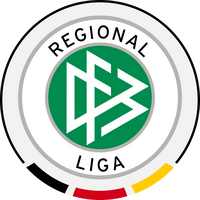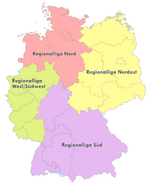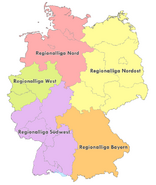| Regionalliga | |

| |
| Country | |
|---|---|
| Confederation | UEFA (Europe) |
| Number of teams | 93 |
| Promotion to | 3. Liga |
| Relegation to | Oberliga |
| Levels on pyramid | 4 |
| Current champions | VfB Oldenburg (Nord) BFC Dynamo (Nordost) Rot-Weiss Essen (West) SV Elversberg (Südwest) SpVgg Bayreuth (Bayern) (2021–22) |
The Regionalliga (German pronunciation: reeg-yon-al-lee-ga) is the fourth tier of football in the German football league system. Until 1974, it was the second tier of the league system before being disbanded. The Regionalliga was then re-introduced as the third tier of the system in 1994. Upon introduction of a new nationwide 3. Liga in 2008, it was demoted to the fourth level of the pyramid.
History of the Regionalligas[]
1963 to 1974[]
From the introduction of the Bundesliga in 1963 until the formation of the 2. Bundesliga in 1974, there were five Regionalligas, forming the second tier of German Football:
- Regionalliga Nord, (covering the states of Niedersachsen, Schleswig-Holstein, Bremen and Hamburg)
- Regionalliga West, (covering the state of Nordrhein-Westfalen)
- Regionalliga Berlin, (covering West-Berlin)
- Regionalliga Südwest, (covering the states of Rheinland-Pfalz and Saarland)
- Regionalliga Süd, (covering the states of Bayern, Hessen and Baden-Württemberg)
The champions and runners-up of the respective divisions played out two promotion spots to the Bundesliga in two groups after the end of the season.
In 1974, the two 2. Bundesligas, Süd and Nord became the second tier of German Football and the Regionalligas ceased existing for the next 20 years.
1994 to 2000[]
In 1994, the Regionalligas were re-introduced, this time as the third tier of German Football. There were initially four Regionalligas:
- Regionalliga Süd, (covering the states of Bayern, Hessen and Baden-Württemberg)
- Regionalliga West/Südwest, (covering the states of Rheinland-Pfalz, Saarland and Nordrhein-Westfalen)
- Regionalliga Nord, (covering the states of Niedersachsen, Schleswig-Holstein, Bremen and Hamburg)
- Regionalliga Nordost, (covering the states of Brandenburg, Berlin, Mecklenburg-Vorpommern, Sachsen-Anhalt, Thüringen and Sachsen; i.e. the former GDR and the city of Berlin)
Between 1994 and 2000, promotion to the 2. Bundesliga was regulated without much continuity. It was a problematic rule, as becoming champion of a division did not automatically mean promotion for that team. The champions of the South and West/Southwest divisions were automatically promoted, however, along with one of the two runners-up. The champions of the North and Northeast divisions had a play-off to decide who would get the fourth promotion spot. This rule was justified because there are more clubs in the southern part of Germany than the north.
In 1998, the promotion rule was changed again: the winner of the play-off between the North and Northeast division champions was promoted, while the loser faced the runners-up from the West/Southwest and South divisions in another play-off for the remaining promotion spot.
2000 to 2008[]
In 2000 the number of Regionalligas was reduced to two:
- Regionalliga Nord, (covering northern Germany)
- Regionalliga Süd, (covering southern Germany)
The new divisional alignment was not bound to certain states any more so teams could be moved between the divisions in order to balance club numbers. This led to some clubs in the Southern division being geographically further north than some northern clubs, and vice versa.
The champions and the runners-up of both divisions were promoted to the 2. Bundesliga.
2008 to 2012[]
In 2008, the Regionalliga was demoted to become the fourth tier of football in Germany after the introduction of a new nationwide 3. Liga. However, there was an expansion to three divisions:
- Regionalliga Nord, (covering the states of Brandenburg, Berlin, Mecklenburg-Vorpommern, Sachsen-Anhalt, Thüringen, Sachsen, Niedersachsen, Schleswig-Holstein, Bremen and Hamburg
- Regionalliga Süd, (covering the states of Bayern, Hessen and Baden-Württemberg)
- Regionalliga West, (covering the states of Rheinland-Pfalz, Saarland and Nordrhein-Westfalen)
"Covering" means that the single divisions will be annually re-aligned to geographic location by a DFB committee in order to have 18 teams assigned to each division every year. This may lead to teams assigned to a division other than their geographical one. An example for this is BV Cloppenburg, who was assigned to the Western division for the 2008–09 season despite being located in Niedersachsen.
2012 onwards[]
In October 2010, yet another reform of the Regionalligas was decided upon. The number of leagues were now to be expanded to five, with the defunct Regionalliga Nordost to be reestablished and a Regionalliga Bayern to be established. Also, the Regionalliga West would lose the clubs from the south west to a new league, formed out of those clubs and the clubs from Regionalliga Süd without the Bavarian teams. The new system is due to come into operation in the 2012–13 season. It was also decided to limit the number of reserve teams per Regionalliga to seven.
The five league champions and the runners-up of the Regionalliga Süd/Südwest will then play-off for the three promotion spots in a home-and-away series. The new leagues will consist of up to 22 clubs in their inaugural season but will then have to be reduced to between 16 and 18 clubs. The Regionalligas will not be administrated by the DFB but rather by the regional football associations. In regards to reserve teams, initially only seven are permitted per league, however, this rule may be subject to change under certain circumstances. Reserve sides of 3. Liga teams are not permitted in the Regionalliga.
The reorganisation of the Regionalligas so soon after the last changes in 2008 became necessary because of a large number of insolvencies. These were caused by a lack of media interest in the leagues combined with large expenses and infrastructure demands. The five Regionalligas from 2012 are:
- Regionalliga Nord, (covering the states of Lower Saxony, Schleswig-Holstein, Bremen and Hamburg)
- Regionalliga Nordost, (covering the states of Brandenburg, Berlin, Mecklenburg-Vorpommern, Saxony-Anhalt, Thuringia and Saxony)
- Regionalliga West, (covering the state of North Rhine-Westphalia)
- Regionalliga Südwest, (covering the states of Rhineland-Palatinate, Saarland, Hesse and Baden-Württemberg)
- Regionalliga Bayern, (covering the state of Bavaria)
Some regional football associations, like the Bavarian one, have also made changes to the league system below the Regionalliga in their area. The Bavarian FA is introduction two Bayernligas below the Regionalliga and increasing the number of Landesligas from three to five below the new Verbandsligas.
Maps[]
The history and development of the Regionalligas in maps:
League setup[]
Licensing[]
A club that wants to play in the Regionalliga must meet two conditions. First, the team must qualify for the league. Second, the club must obtain a license from the DFB. This license is granted if the club can prove that they are financially sound, that their stadium conforms to the security regulations, and that they have a working youth section.
Promotion[]
The champions of each division take part in the promotion round to the 3. Liga at the end of the season. Reserve teams will also be eligible for promotion unless the respective first team is playing in the 3. Liga.
Relegation[]
The bottom three teams of each division are demoted to their respective Oberliga. In the Regionalliga Nord, the fourth-to-last team will also be demoted.
As clubs in the Regionalliga must have their teams licensed by the DFB on a per-season basis, a team may also be relegated by having its license revoked or by going into administration. Reserve teams are also relegated when the respective first team is relegated to the 3. Liga.
Squad rules[]
Matchday squads in the Regionalliga must include at least six players of German nationality and under the age of 24, two under the age of 21, and a maximum of three non-EU players.
Champions[]
1963–1974[]
| Season | Regionalliga Nord | Regionalliga West | Regionalliga Berlin | Regionalliga Südwest | Regionalliga Süd |
|---|---|---|---|---|---|
| 1963–64 | FC St. Pauli | Alemannia Aachen | SC Tasmania 1900 Berlin | Borussia Neunkirchen | KSV Hessen Kassel |
| 1964–65 | Borussia Mönchengladbach | Tennis Borussia Berlin | 1. FC Saarbrücken | ||
| 1965–66 | FC St. Pauli | Fortuna Düsseldorf | Hertha BSC | FK Pirmasens | 1. FC Schweinfurt 05 |
| 1966–67 | Arminia Hannover | Alemannia Aachen | Hertha BSC | Borussia Neunkirchen | Kickers Offenbach |
| 1967–68 | Arminia Hannover | Bayer Leverkusen | Hertha BSC | SV Alsenborn | SpVgg Bayern Hof |
| 1968–69 | Rot-Weiss Oberhausen | Hertha Zehlendorf | SV Alsenborn | ||
| 1969–70 | VfL Osnabrück | VfL Bochum | Hertha Zehlendorf | SV Alsenborn | Kickers Offenbach |
| 1970–71 | VfL Osnabrück | VfL Bochum | SC Tasmania 1900 Berlin | Borussia Neunkirchen | 1. FC Nürnberg |
| 1971–72 | FC St. Pauli | Wuppertaler SV | SC Wacker 04 Berlin | Borussia Neunkirchen | Kickers Offenbach |
| 1972–73 | FC St. Pauli | Rot-Weiss Essen | Blau-Weiß 1890 Berlin | FSV Mainz 05 | SV Darmstadt 98 |
| 1973–74 | Eintracht Braunschweig | SG Wattenscheid 09 | Tennis Borussia Berlin | Borussia Neunkirchen | FC Augsburg |
1994–2000[]
| Season | Regionalliga Nord | Regionalliga Nordost | Regionalliga West/Südwest | Regionalliga Süd |
|---|---|---|---|---|
| 1994–95 | VfB Lübeck | Carl Zeiss Jena | Arminia Bielefeld | SpVgg Unterhaching |
| 1995–96 | Tennis Borussia Berlin | FC Gütersloh | Stuttgarter Kickers | |
| 1996–97 | Hannover 96 | FC Energie Cottbus | SG Wattenscheid 09 | 1. FC Nürnberg |
| 1997–98 | Hannover 96 | Tennis Borussia Berlin | Rot-Weiß Oberhausen | SSV Ulm 1846 |
| 1998–99 | VfL Osnabrück | Alemannia Aachen | SV Waldhof Mannheim | |
| 1999–2000 | VfL Osnabrück | 1. FC Union Berlin | 1. FC Saarbrücken | SSV Reutlingen 05 |
2000–2008[]
| Season | Regionalliga Nord | Regionalliga Süd |
|---|---|---|
| 2000–01 | 1. FC Union Berlin | |
| 2001–02 | VfB Lübeck | Wacker Burghausen |
| 2002–03 | Erzgebirge Aue | SpVgg Unterhaching |
| 2003–04 | Rot-Weiss Essen | Bayern Munich II |
| 2004–05 | Eintracht Braunschweig | Kickers Offenbach |
| 2005–06 | Rot-Weiss Essen | FC Augsburg |
| 2006–07 | FC St. Pauli | SV Wehen |
| 2007–08 | Rot Weiss Ahlen |
2008–2012[]
| Season | Regionalliga Nord | Regionalliga West | Regionalliga Süd |
|---|---|---|---|
| 2008–09 | Holstein Kiel | Borussia Dortmund II | 1. FC Heidenheim |
| 2009–10 | SV Babelsberg 03 | 1. FC Saarbrücken | VfR Aalen |
| 2010–11 | Chemnitzer FC | Preußen Münster | SV Darmstadt 98 |
| 2011–12 | Borussia Dortmund II | Stuttgarter Kickers |
2012–[]
| Season | Regionalliga Nord | Regionalliga Nordost | Regionalliga West | Regionalliga Südwest | Regionalliga Bayern |
|---|---|---|---|---|---|
| 2012–13 | Holstein Kiel | RB Leipzig | Sportfreunde Lotte | KSV Hessen Kassel | TSV 1860 München II |
| 2013–14 | VfL Wolfsburg II | TSG Neustrelitz | SC Fortuna Köln | SG Sonnenhof Großaspach | Bayern Munich II |
| 2014–15 | Werder Bremen II | 1. FC Magdeburg | Borussia Mönchengladbach II | Kickers Offenbach | Würzburger Kickers |
| 2015–16 | VfL Wolfsburg II | FSV Zwickau | Sportfreunde Lotte | SV Waldhof Mannheim | SSV Jahn Regensburg |
| 2016–17 |
External links[]
- Regionalliga on the official DFB website
- Ergebnisdienst des DFB
- news, results, statistics, team and player profiles
Template:Regionalliga Nord Template:Regionalliga Nordost Template:Regionalliga West Template:Regionalliga Süd Template:Fußball-Regionalliga Bayern
| Football in Germany | |||||||||||||||||||||||||||||
| |||||||||||||||||||||||||||||
| Regionalliga seasons |
|
2015–16 · 2016–17 · 2017–18 · 2018–19 · 2019–20 · 2020–21 · 2021–22 · 2022–23 · 2023–24 · |
| Regionalliga |
| Regionalliga Bayern · Regionalliga Nord · Regionalliga Nordost · Regionalliga Südwest · Regionalliga West |
| Fourth level football leagues of Europe – (UEFA) |
|
Albania · Austria · Belgium · Bosnia and Herzegovina · Bulgaria · Croatia · Cyprus · Czech Republic · Denmark · England · Estonia · Faroe Islands · Finland · France · Germany · Greece · Hungary · Iceland · Rep. of Ireland · Israel · Italy · Latvia · Lithuania · Luxembourg · Rep. of Macedonia · Malta · Montenegro · Netherlands · Northern Ireland · Norway · Poland · Portugal · Romania · Russia · Scotland · Serbia · Slovakia · Slovenia · Spain · Sweden · Switzerland · Turkey · Ukraine · Wales |





